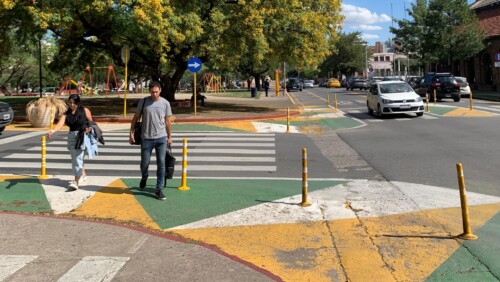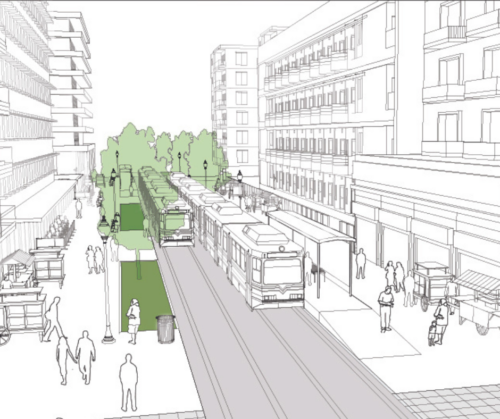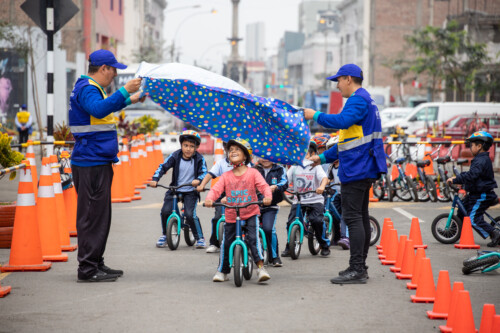
February 16, 2021
For both the national and global teams at NACTO, 2020 was a year for the books—one that required compassion, collaboration, and quick action to adjust to new ways of living, working, and supporting each other and our partner cities.
At GDCI, in addition to adapting many of our trainings and implementation work to a virtual format, much of our effort in 2020 was focused on providing COVID-19 resources so that cities and communities could learn from and support each other as they responded to the ever-changing needs and challenges posed by the pandemic.
NACTO’s 2020 Annual Report—”Cities Taking the Lead”—is now available here, and we invite you to join us in celebrating the work and milestones of NACTO, GDCI, and our partner cities throughout this unprecedented year.
The overlapping crises of this year, and [cities’] responses to them, demonstrated that transforming streets is not only possible—but necessary—to address structural inequalities, a faltering economic recovery, and a changing climate. These challenges are enormous, but the radical optimism infused into NACTO’s work compels us to keep pushing.
– Corinne Kisner, Executive Director
Highlights from GDCI
In 2020, The Global Designing Cities Initiative (GDCI) continued to offer technical assistance and guidance based on the Global Street Design Guide to help cities around the world shape safe and sustainable urban streets. This year, while every region of the globe confronted the physical, social, and economic toll of the COVID-19 pandemic, GDCI focused on supporting response and recovery efforts in our partner cities—while conducting capacity-building workshops, trainings, and presentations for practitioners around the world and supporting 15 implementation projects that that led to the transformation of 7+ km of streets.
In addition to detailing our 2020 city work with both the Bloomberg Initiative for Global Road Safety (BIGRS) and Streets for Kids programs—as well as ongoing street transformations in Milan, Italy and Istanbul, Turkey—other major milestones highlighted in the report include:

Reflecting the flexibility and creativity that transportation practitioners have demonstrated throughout the pandemic, Streets for Pandemic Response and Recovery compiles emerging practices and strategies that cities can use to promote public health on their streets, while acting quickly and equitably. Following its release in May 2020, GDCI translated the resource into nine additional languages—Arabic, French, Italian, Japanese, Mandarin, Portuguese, Russian, Spanish, and Turkish—expanding its international reach and providing tools and support to a global network of cities.
Released in August as a supplement to the Global Street Design Guide, Designing Streets for Kids builds on the approach of putting people first, focusing on the specific needs of children and caregivers using urban streets as pedestrians, cyclists, and transit users. The guide includes numerous case studies of projects, programs, and policies from cities around the world, and discusses different street design strategies to make streets safer and more playful. Download the guide here.
Under the Streets for Kids program, the GDCI team began work in four new cities in 2020—Tirana, Albania; Fortaleza, Brazil; Santiago, Chile; and Kigali, Rwanda—to implement child-focused street transformation projects.
In this exciting video, released in December 2020, NACTO-GDCI celebrates its partnership with five major cities as part of the Bloomberg Initiative for Global Road Safety—highlighting the tremendous work of our partner cities of Addis Ababa, Ethiopia; Bogotá, Colombia; Fortaleza, Brazil; São Paulo, Brazil; and Mumbai, India. In 2020, as part of Phase III of this groundbreaking program, GDCI also began work in eight new cities (including two continuing cities*): Recife and Salvador (Brazil), Bogotá* and Cali (Colombia), Guyaquil and Quito (Ecuador), and Delhi and Mumbai* (India).

In October, in partnership with the International Road Assessment Program (iRAP), GDCI launched an important supplement to the Global Street Design Guide, which outlines the safety benefits of improved designs using iRAP’s Star Rating methodology—the global standard for benchmarking road infrastructure safety. Download the resource here.
 In 2020, joining the list of 100+ cities, regions, countries, and organizations across the world who have endorsed the Global Street Design Guide, are the cities of Istanbul (Turkey), Cali (Colombia), and Bratislava (Slovakia), along with 3 organizations: Global y Local (Argentina), Society of Road Safety Ambassadors (Botswana), and Streets Alive Yarra (Australia). The Global Street Design Guide is currently available in English, Chinese, Italian, Portuguese, and Spanish—and the Spanish translation is now available for free download.
In 2020, joining the list of 100+ cities, regions, countries, and organizations across the world who have endorsed the Global Street Design Guide, are the cities of Istanbul (Turkey), Cali (Colombia), and Bratislava (Slovakia), along with 3 organizations: Global y Local (Argentina), Society of Road Safety Ambassadors (Botswana), and Streets Alive Yarra (Australia). The Global Street Design Guide is currently available in English, Chinese, Italian, Portuguese, and Spanish—and the Spanish translation is now available for free download.
We hope you will view NACTO’s 2020 Annual Report in its entirety, and join us in celebrating our achievements as we reflect on—and recommit to—the work of transforming our streets to create safer, healthier, and more sustainable cities.
Read NACTO’s 2020 Annual Report







